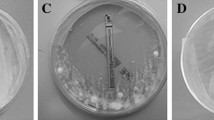Abstract
The in vitro activity of saperconazole against 228 strains of mycotic agents belonging to 48 species was investigated. Susceptibility testing was performed using a microtiter broth dilution method. Isolates of Candida albicans, C. tropicalis and Torulopsis glabrata showed distinct intra-species variation of susceptibility with MIC values ranging from 0.045 to 100 mg l−1. The drug was inhibitory for the dermatophytes at a relatively narrow range of concentrations, most isolates being inhibited at MIC 0.78 mg l−1. The strongest antifungal potency of saperconazole was exerted against clinical isolates of the genus Aspergillus (MIC 90% = 0.19 mg l−1). Concentrations up to 100 mg l−1 had no macroscopically recognizable effect on the growth of zygomycetous fungi (Mucor, Rhizopus, Syncephalastrum). Species of the genus Absidia with their good sensitivity are an exception. Justification of in vitro susceptibility testing of triazoles is discussed. In the author's opinion, MIC values can serve as an informative parameter showing the range of indications of these antifungals for treatment. It is concluded that saperconazole exhibits a very good activity against a broad spectrum of medically important fungi in vitro and can be considered a promising antifungal drug.
Similar content being viewed by others
References
Otčenášek M. The in vitro susceptibility of some mycotic agents to a new orally active triazole, itraconazole. J Hyg Epidemiol Microbiol Immunol 1990; 34: 129–134.
Otčenášek M, Kuklová I. Itraconazole: Characteristics and evaluation of a new systemic antimycotic. Janssen Res News 1991; 16: 2–13.
Van Cutsem J, Van Gerven F, Janssen PAJ. Activity of orally, topically, and parenterally administered itraconazole in the treatment of superficial and deep mycoses: animal models. Rev Inf Dis 1987; 9 (Suppl 1): 15–32.
Van Cutsem J, Van Gerven F, Janssen PAJ. Saperconazole, a new potent antifungal triazole: in vitro activity spectrum and therapeutic efficacy. Drugs Fut 1989; 14: 1187–1209.
Odds FC. Antifungal activity of saperconazole (R 66905) in vitro. J Antimicrob Chemoth 1989; 24: 533–538.
Mallié M, Montes B, Lebecq JC, Bastide JM. In vitro antifungal activity of saperconazole (R 66905) against Candida and Torulopsis. Mycoses 1989; 32: 631–637.
Werk R, Knothe H. Comparison of agar dilution test, broth dilution test and broth elution test for assaying susceptibility of Candida spp. Curr Microbiol 1984; 10: 173–176.
Van Cutsem J, Van Gerven F, Van der Flaes M, Cauwenbergh G, Janssen PAJ. Antifungal plasma levels of saperconazole after oral and parenteral administration in guinea pigs as determined by bioassay. Proc 16th Intern Congress Chemotherapy, Israel, June 1989; pp. 537.1–537.2.
Drouhet E. Standardization of antifungal susceptibility testing: An introductory overview. Proc 10th Congress ISHAM, Barcelona, June 1988: 203–209.
Kobayashi JS, Spitzer ED. Testing of organisms for susceptibility to triazoles: is it justified?Eur J Clin Microbiol Inf Dis 1989; 8: 387–389.
Van Cutsem J, Van Gerven F, Janssen PAJ. Oral and parenteral therapy with saperconazole (R 66905) of invasive aspergillosis in normal and immunocompromised animals. Antimicrob Agents Chemoth 1989; 33: 2063–2968.
Author information
Authors and Affiliations
Rights and permissions
About this article
Cite this article
Otčenášek, M. Susceptibility of clinical isolates of fungi to saperconazole. Mycopathologia 118, 179–183 (1992). https://doi.org/10.1007/BF00437152
Received:
Accepted:
Issue Date:
DOI: https://doi.org/10.1007/BF00437152




